Social Work Letter: Aged Care Policy and Media Campaign Proposal
VerifiedAdded on 2023/01/04
|9
|2316
|20
Homework Assignment
AI Summary
This assignment is a letter written by a social work student to the president of the Australian Association of Social Workers (AASW). The letter addresses the social policy issue of aged care in Australia, prompted by a media article detailing neglect and abuse within care facilities. The student analyzes the policy issue, critiques the values and evidence presented in the media, and proposes that the AASW launch a media campaign to advocate for improved care, particularly for culturally and linguistically diverse (CALD) elderly individuals. The letter highlights the importance of equality and professionalism in aged care, emphasizing the negative impacts of current practices on vulnerable groups and suggesting policy responses to improve living conditions and promote accountability within the sector. The student references relevant literature to support their arguments and calls for the AASW's involvement in addressing this critical social issue.

Running head: LETTER 1
Letter
Name
Institution
Letter
Name
Institution
Paraphrase This Document
Need a fresh take? Get an instant paraphrase of this document with our AI Paraphraser
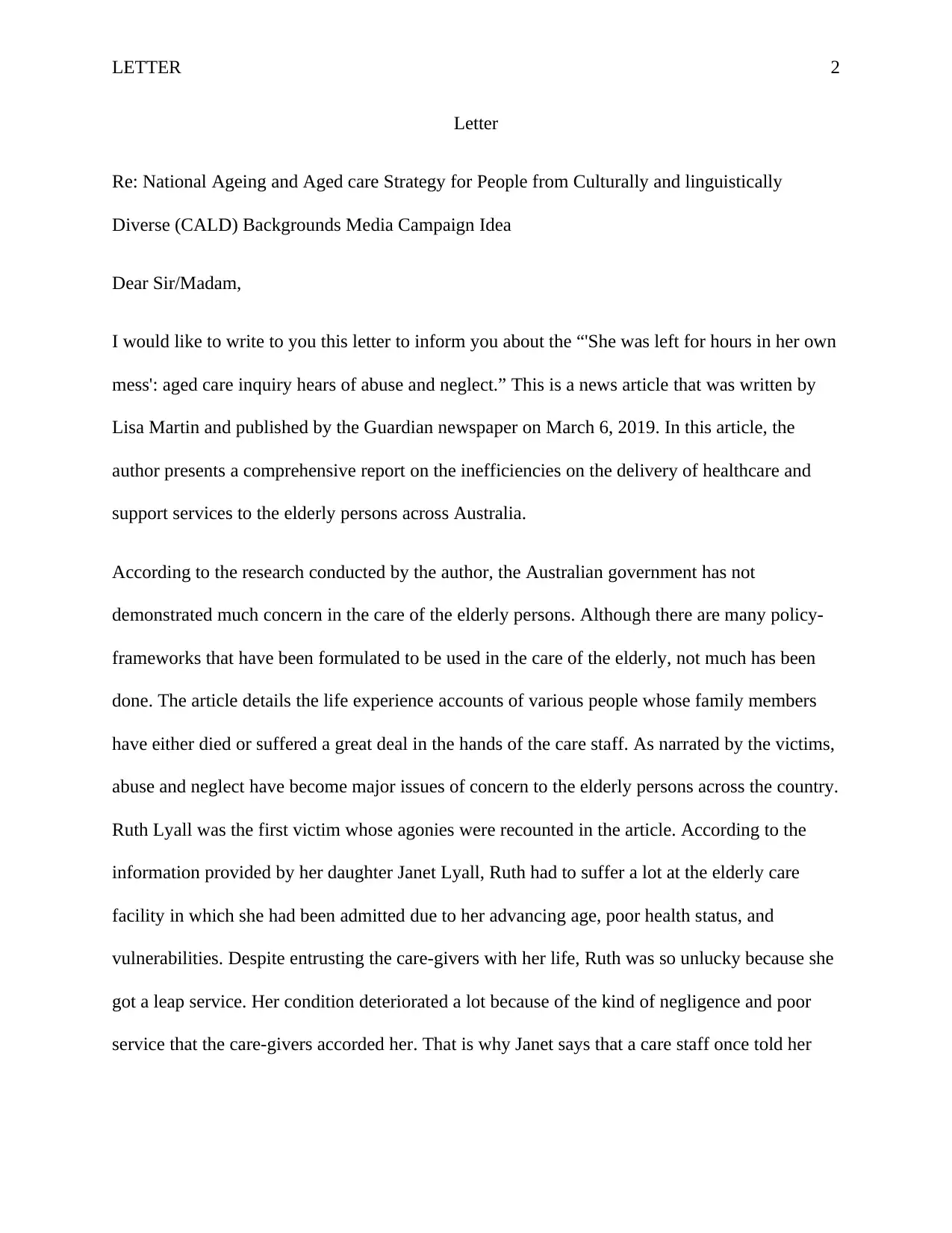
LETTER 2
Letter
Re: National Ageing and Aged care Strategy for People from Culturally and linguistically
Diverse (CALD) Backgrounds Media Campaign Idea
Dear Sir/Madam,
I would like to write to you this letter to inform you about the “'She was left for hours in her own
mess': aged care inquiry hears of abuse and neglect.” This is a news article that was written by
Lisa Martin and published by the Guardian newspaper on March 6, 2019. In this article, the
author presents a comprehensive report on the inefficiencies on the delivery of healthcare and
support services to the elderly persons across Australia.
According to the research conducted by the author, the Australian government has not
demonstrated much concern in the care of the elderly persons. Although there are many policy-
frameworks that have been formulated to be used in the care of the elderly, not much has been
done. The article details the life experience accounts of various people whose family members
have either died or suffered a great deal in the hands of the care staff. As narrated by the victims,
abuse and neglect have become major issues of concern to the elderly persons across the country.
Ruth Lyall was the first victim whose agonies were recounted in the article. According to the
information provided by her daughter Janet Lyall, Ruth had to suffer a lot at the elderly care
facility in which she had been admitted due to her advancing age, poor health status, and
vulnerabilities. Despite entrusting the care-givers with her life, Ruth was so unlucky because she
got a leap service. Her condition deteriorated a lot because of the kind of negligence and poor
service that the care-givers accorded her. That is why Janet says that a care staff once told her
Letter
Re: National Ageing and Aged care Strategy for People from Culturally and linguistically
Diverse (CALD) Backgrounds Media Campaign Idea
Dear Sir/Madam,
I would like to write to you this letter to inform you about the “'She was left for hours in her own
mess': aged care inquiry hears of abuse and neglect.” This is a news article that was written by
Lisa Martin and published by the Guardian newspaper on March 6, 2019. In this article, the
author presents a comprehensive report on the inefficiencies on the delivery of healthcare and
support services to the elderly persons across Australia.
According to the research conducted by the author, the Australian government has not
demonstrated much concern in the care of the elderly persons. Although there are many policy-
frameworks that have been formulated to be used in the care of the elderly, not much has been
done. The article details the life experience accounts of various people whose family members
have either died or suffered a great deal in the hands of the care staff. As narrated by the victims,
abuse and neglect have become major issues of concern to the elderly persons across the country.
Ruth Lyall was the first victim whose agonies were recounted in the article. According to the
information provided by her daughter Janet Lyall, Ruth had to suffer a lot at the elderly care
facility in which she had been admitted due to her advancing age, poor health status, and
vulnerabilities. Despite entrusting the care-givers with her life, Ruth was so unlucky because she
got a leap service. Her condition deteriorated a lot because of the kind of negligence and poor
service that the care-givers accorded her. That is why Janet says that a care staff once told her
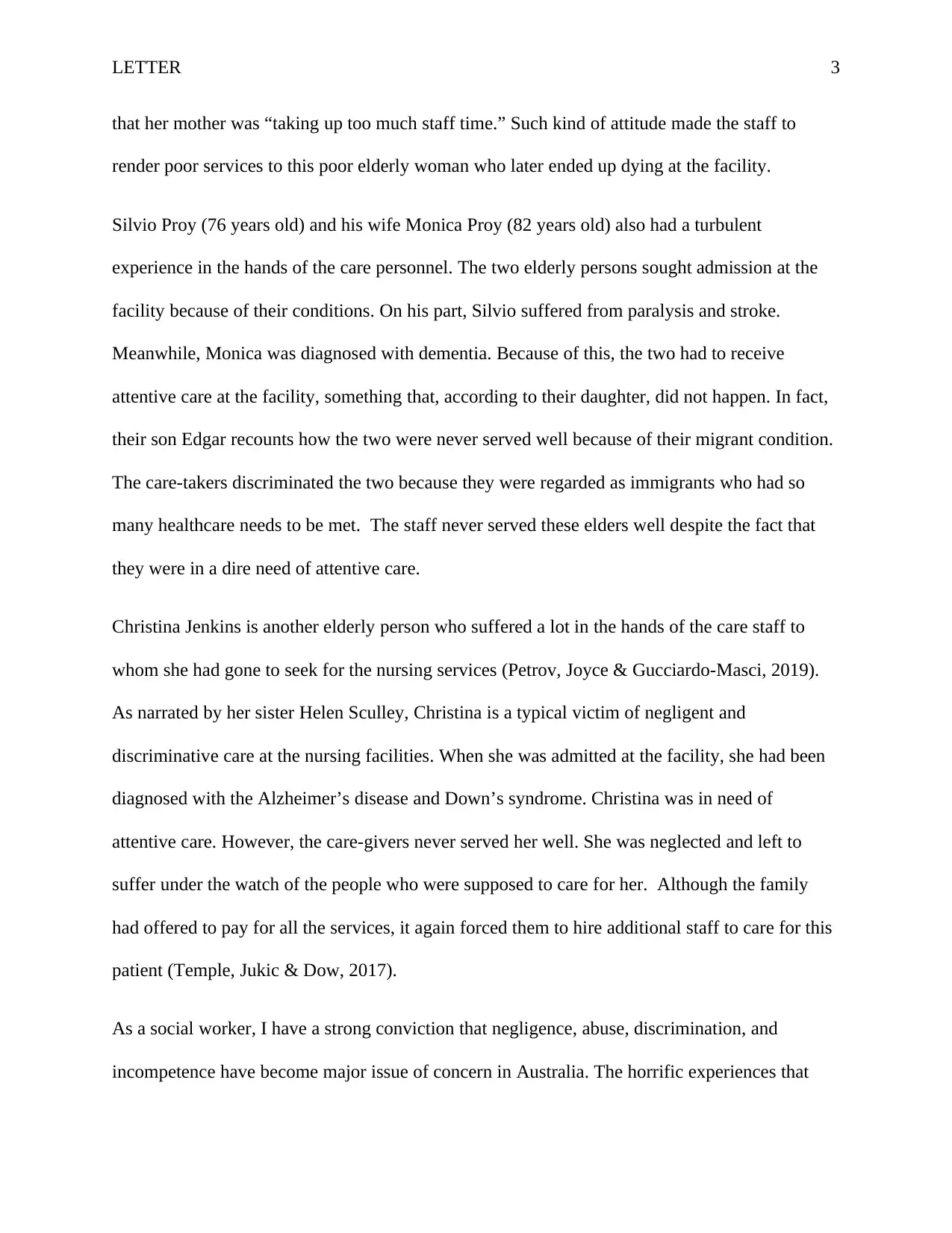
LETTER 3
that her mother was “taking up too much staff time.” Such kind of attitude made the staff to
render poor services to this poor elderly woman who later ended up dying at the facility.
Silvio Proy (76 years old) and his wife Monica Proy (82 years old) also had a turbulent
experience in the hands of the care personnel. The two elderly persons sought admission at the
facility because of their conditions. On his part, Silvio suffered from paralysis and stroke.
Meanwhile, Monica was diagnosed with dementia. Because of this, the two had to receive
attentive care at the facility, something that, according to their daughter, did not happen. In fact,
their son Edgar recounts how the two were never served well because of their migrant condition.
The care-takers discriminated the two because they were regarded as immigrants who had so
many healthcare needs to be met. The staff never served these elders well despite the fact that
they were in a dire need of attentive care.
Christina Jenkins is another elderly person who suffered a lot in the hands of the care staff to
whom she had gone to seek for the nursing services (Petrov, Joyce & Gucciardo-Masci, 2019).
As narrated by her sister Helen Sculley, Christina is a typical victim of negligent and
discriminative care at the nursing facilities. When she was admitted at the facility, she had been
diagnosed with the Alzheimer’s disease and Down’s syndrome. Christina was in need of
attentive care. However, the care-givers never served her well. She was neglected and left to
suffer under the watch of the people who were supposed to care for her. Although the family
had offered to pay for all the services, it again forced them to hire additional staff to care for this
patient (Temple, Jukic & Dow, 2017).
As a social worker, I have a strong conviction that negligence, abuse, discrimination, and
incompetence have become major issue of concern in Australia. The horrific experiences that
that her mother was “taking up too much staff time.” Such kind of attitude made the staff to
render poor services to this poor elderly woman who later ended up dying at the facility.
Silvio Proy (76 years old) and his wife Monica Proy (82 years old) also had a turbulent
experience in the hands of the care personnel. The two elderly persons sought admission at the
facility because of their conditions. On his part, Silvio suffered from paralysis and stroke.
Meanwhile, Monica was diagnosed with dementia. Because of this, the two had to receive
attentive care at the facility, something that, according to their daughter, did not happen. In fact,
their son Edgar recounts how the two were never served well because of their migrant condition.
The care-takers discriminated the two because they were regarded as immigrants who had so
many healthcare needs to be met. The staff never served these elders well despite the fact that
they were in a dire need of attentive care.
Christina Jenkins is another elderly person who suffered a lot in the hands of the care staff to
whom she had gone to seek for the nursing services (Petrov, Joyce & Gucciardo-Masci, 2019).
As narrated by her sister Helen Sculley, Christina is a typical victim of negligent and
discriminative care at the nursing facilities. When she was admitted at the facility, she had been
diagnosed with the Alzheimer’s disease and Down’s syndrome. Christina was in need of
attentive care. However, the care-givers never served her well. She was neglected and left to
suffer under the watch of the people who were supposed to care for her. Although the family
had offered to pay for all the services, it again forced them to hire additional staff to care for this
patient (Temple, Jukic & Dow, 2017).
As a social worker, I have a strong conviction that negligence, abuse, discrimination, and
incompetence have become major issue of concern in Australia. The horrific experiences that
⊘ This is a preview!⊘
Do you want full access?
Subscribe today to unlock all pages.

Trusted by 1+ million students worldwide
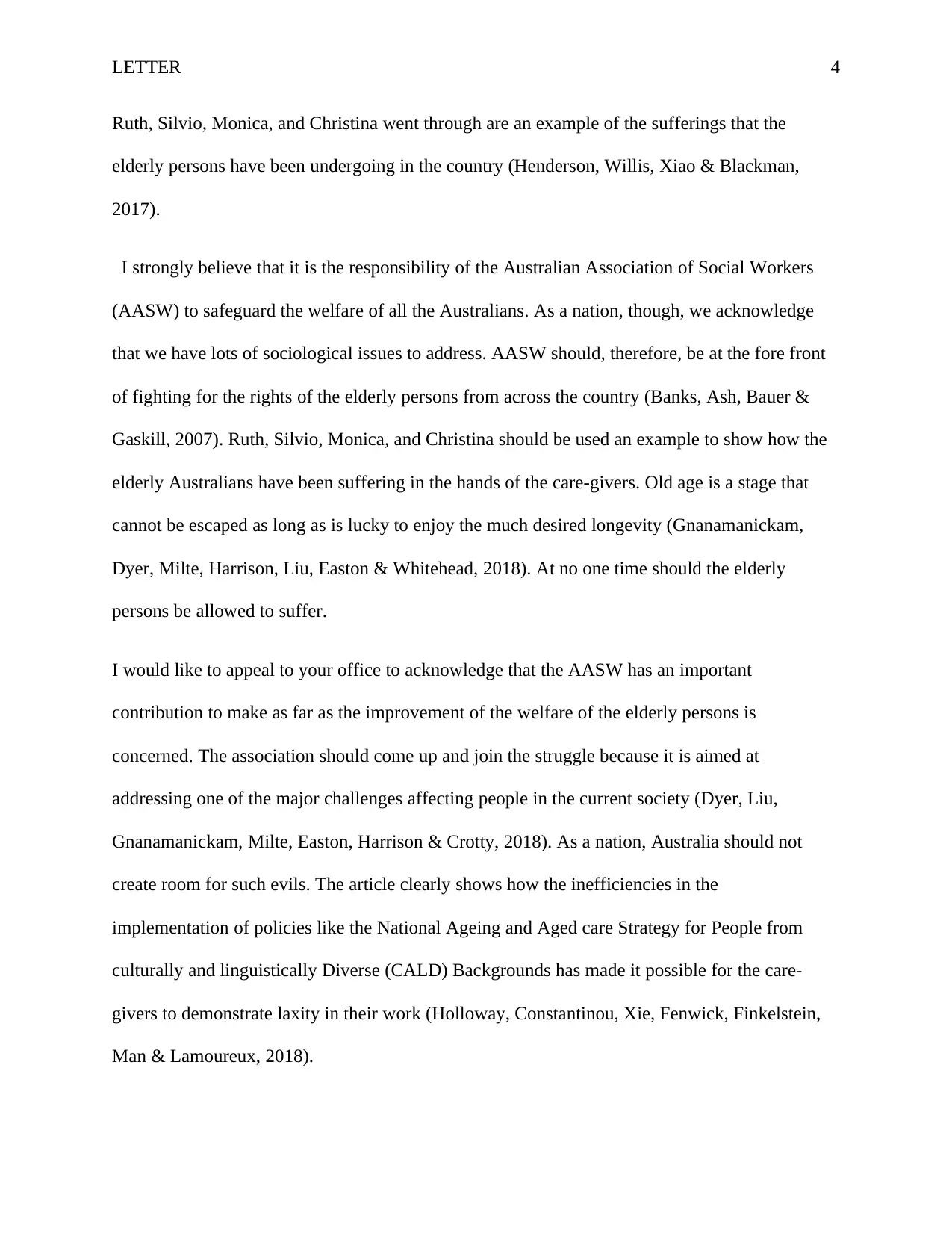
LETTER 4
Ruth, Silvio, Monica, and Christina went through are an example of the sufferings that the
elderly persons have been undergoing in the country (Henderson, Willis, Xiao & Blackman,
2017).
I strongly believe that it is the responsibility of the Australian Association of Social Workers
(AASW) to safeguard the welfare of all the Australians. As a nation, though, we acknowledge
that we have lots of sociological issues to address. AASW should, therefore, be at the fore front
of fighting for the rights of the elderly persons from across the country (Banks, Ash, Bauer &
Gaskill, 2007). Ruth, Silvio, Monica, and Christina should be used an example to show how the
elderly Australians have been suffering in the hands of the care-givers. Old age is a stage that
cannot be escaped as long as is lucky to enjoy the much desired longevity (Gnanamanickam,
Dyer, Milte, Harrison, Liu, Easton & Whitehead, 2018). At no one time should the elderly
persons be allowed to suffer.
I would like to appeal to your office to acknowledge that the AASW has an important
contribution to make as far as the improvement of the welfare of the elderly persons is
concerned. The association should come up and join the struggle because it is aimed at
addressing one of the major challenges affecting people in the current society (Dyer, Liu,
Gnanamanickam, Milte, Easton, Harrison & Crotty, 2018). As a nation, Australia should not
create room for such evils. The article clearly shows how the inefficiencies in the
implementation of policies like the National Ageing and Aged care Strategy for People from
culturally and linguistically Diverse (CALD) Backgrounds has made it possible for the care-
givers to demonstrate laxity in their work (Holloway, Constantinou, Xie, Fenwick, Finkelstein,
Man & Lamoureux, 2018).
Ruth, Silvio, Monica, and Christina went through are an example of the sufferings that the
elderly persons have been undergoing in the country (Henderson, Willis, Xiao & Blackman,
2017).
I strongly believe that it is the responsibility of the Australian Association of Social Workers
(AASW) to safeguard the welfare of all the Australians. As a nation, though, we acknowledge
that we have lots of sociological issues to address. AASW should, therefore, be at the fore front
of fighting for the rights of the elderly persons from across the country (Banks, Ash, Bauer &
Gaskill, 2007). Ruth, Silvio, Monica, and Christina should be used an example to show how the
elderly Australians have been suffering in the hands of the care-givers. Old age is a stage that
cannot be escaped as long as is lucky to enjoy the much desired longevity (Gnanamanickam,
Dyer, Milte, Harrison, Liu, Easton & Whitehead, 2018). At no one time should the elderly
persons be allowed to suffer.
I would like to appeal to your office to acknowledge that the AASW has an important
contribution to make as far as the improvement of the welfare of the elderly persons is
concerned. The association should come up and join the struggle because it is aimed at
addressing one of the major challenges affecting people in the current society (Dyer, Liu,
Gnanamanickam, Milte, Easton, Harrison & Crotty, 2018). As a nation, Australia should not
create room for such evils. The article clearly shows how the inefficiencies in the
implementation of policies like the National Ageing and Aged care Strategy for People from
culturally and linguistically Diverse (CALD) Backgrounds has made it possible for the care-
givers to demonstrate laxity in their work (Holloway, Constantinou, Xie, Fenwick, Finkelstein,
Man & Lamoureux, 2018).
Paraphrase This Document
Need a fresh take? Get an instant paraphrase of this document with our AI Paraphraser
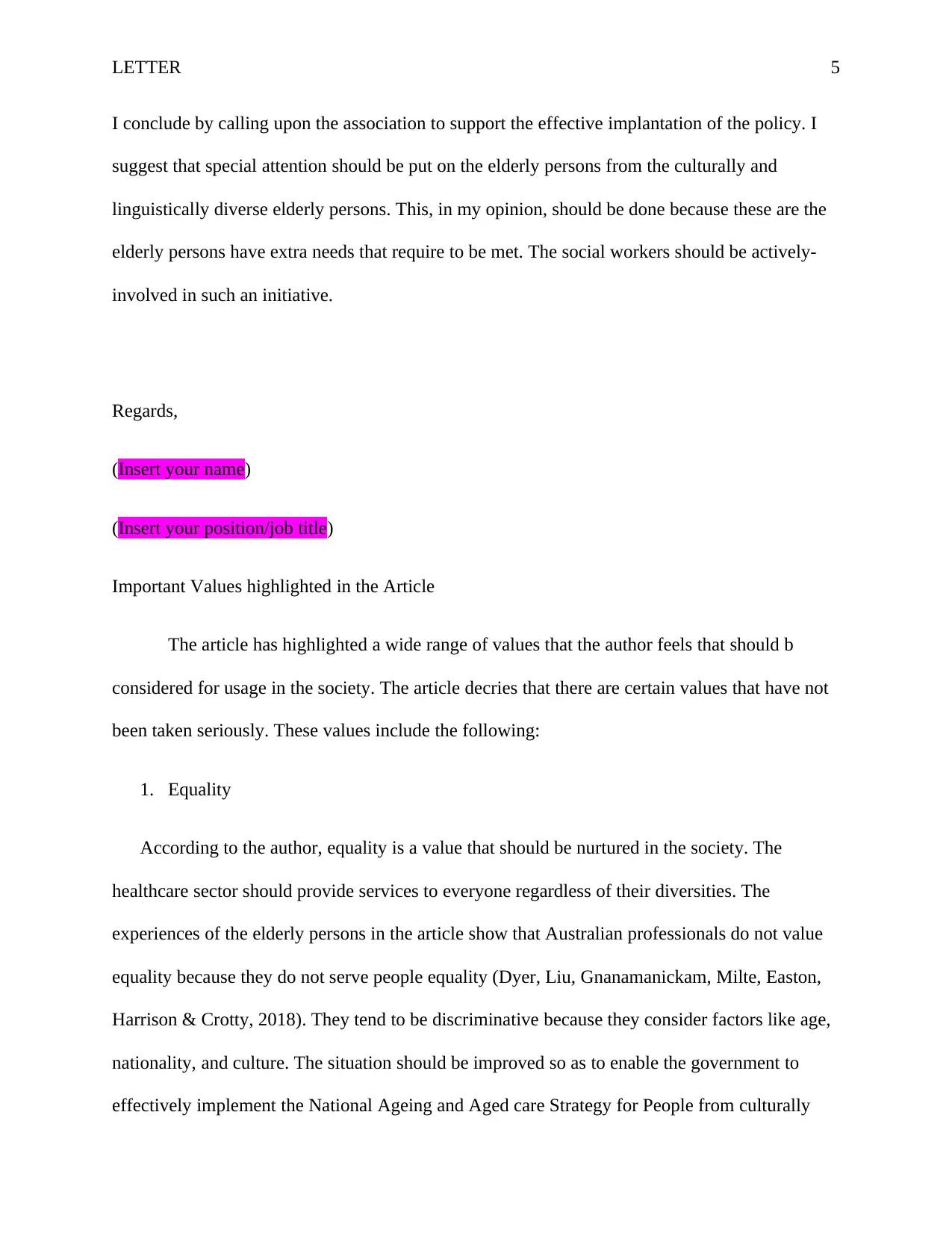
LETTER 5
I conclude by calling upon the association to support the effective implantation of the policy. I
suggest that special attention should be put on the elderly persons from the culturally and
linguistically diverse elderly persons. This, in my opinion, should be done because these are the
elderly persons have extra needs that require to be met. The social workers should be actively-
involved in such an initiative.
Regards,
(Insert your name)
(Insert your position/job title)
Important Values highlighted in the Article
The article has highlighted a wide range of values that the author feels that should b
considered for usage in the society. The article decries that there are certain values that have not
been taken seriously. These values include the following:
1. Equality
According to the author, equality is a value that should be nurtured in the society. The
healthcare sector should provide services to everyone regardless of their diversities. The
experiences of the elderly persons in the article show that Australian professionals do not value
equality because they do not serve people equality (Dyer, Liu, Gnanamanickam, Milte, Easton,
Harrison & Crotty, 2018). They tend to be discriminative because they consider factors like age,
nationality, and culture. The situation should be improved so as to enable the government to
effectively implement the National Ageing and Aged care Strategy for People from culturally
I conclude by calling upon the association to support the effective implantation of the policy. I
suggest that special attention should be put on the elderly persons from the culturally and
linguistically diverse elderly persons. This, in my opinion, should be done because these are the
elderly persons have extra needs that require to be met. The social workers should be actively-
involved in such an initiative.
Regards,
(Insert your name)
(Insert your position/job title)
Important Values highlighted in the Article
The article has highlighted a wide range of values that the author feels that should b
considered for usage in the society. The article decries that there are certain values that have not
been taken seriously. These values include the following:
1. Equality
According to the author, equality is a value that should be nurtured in the society. The
healthcare sector should provide services to everyone regardless of their diversities. The
experiences of the elderly persons in the article show that Australian professionals do not value
equality because they do not serve people equality (Dyer, Liu, Gnanamanickam, Milte, Easton,
Harrison & Crotty, 2018). They tend to be discriminative because they consider factors like age,
nationality, and culture. The situation should be improved so as to enable the government to
effectively implement the National Ageing and Aged care Strategy for People from culturally
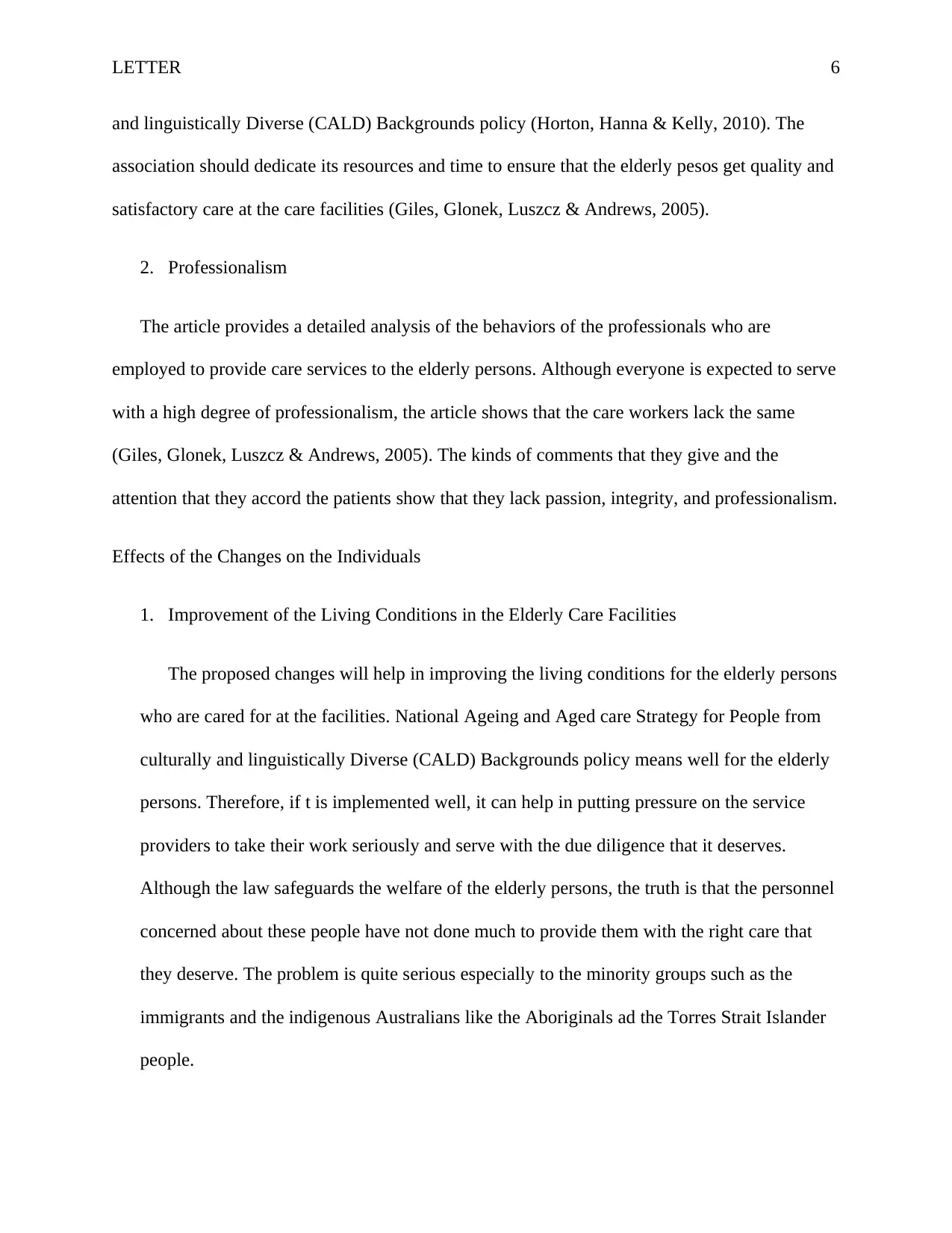
LETTER 6
and linguistically Diverse (CALD) Backgrounds policy (Horton, Hanna & Kelly, 2010). The
association should dedicate its resources and time to ensure that the elderly pesos get quality and
satisfactory care at the care facilities (Giles, Glonek, Luszcz & Andrews, 2005).
2. Professionalism
The article provides a detailed analysis of the behaviors of the professionals who are
employed to provide care services to the elderly persons. Although everyone is expected to serve
with a high degree of professionalism, the article shows that the care workers lack the same
(Giles, Glonek, Luszcz & Andrews, 2005). The kinds of comments that they give and the
attention that they accord the patients show that they lack passion, integrity, and professionalism.
Effects of the Changes on the Individuals
1. Improvement of the Living Conditions in the Elderly Care Facilities
The proposed changes will help in improving the living conditions for the elderly persons
who are cared for at the facilities. National Ageing and Aged care Strategy for People from
culturally and linguistically Diverse (CALD) Backgrounds policy means well for the elderly
persons. Therefore, if t is implemented well, it can help in putting pressure on the service
providers to take their work seriously and serve with the due diligence that it deserves.
Although the law safeguards the welfare of the elderly persons, the truth is that the personnel
concerned about these people have not done much to provide them with the right care that
they deserve. The problem is quite serious especially to the minority groups such as the
immigrants and the indigenous Australians like the Aboriginals ad the Torres Strait Islander
people.
and linguistically Diverse (CALD) Backgrounds policy (Horton, Hanna & Kelly, 2010). The
association should dedicate its resources and time to ensure that the elderly pesos get quality and
satisfactory care at the care facilities (Giles, Glonek, Luszcz & Andrews, 2005).
2. Professionalism
The article provides a detailed analysis of the behaviors of the professionals who are
employed to provide care services to the elderly persons. Although everyone is expected to serve
with a high degree of professionalism, the article shows that the care workers lack the same
(Giles, Glonek, Luszcz & Andrews, 2005). The kinds of comments that they give and the
attention that they accord the patients show that they lack passion, integrity, and professionalism.
Effects of the Changes on the Individuals
1. Improvement of the Living Conditions in the Elderly Care Facilities
The proposed changes will help in improving the living conditions for the elderly persons
who are cared for at the facilities. National Ageing and Aged care Strategy for People from
culturally and linguistically Diverse (CALD) Backgrounds policy means well for the elderly
persons. Therefore, if t is implemented well, it can help in putting pressure on the service
providers to take their work seriously and serve with the due diligence that it deserves.
Although the law safeguards the welfare of the elderly persons, the truth is that the personnel
concerned about these people have not done much to provide them with the right care that
they deserve. The problem is quite serious especially to the minority groups such as the
immigrants and the indigenous Australians like the Aboriginals ad the Torres Strait Islander
people.
⊘ This is a preview!⊘
Do you want full access?
Subscribe today to unlock all pages.

Trusted by 1+ million students worldwide

LETTER 7
2. Enhancement of the Culture of Professionalism and Integrity in the Country
The employees who work in the elderly facilities seem not to be committed in their work.
They do a shoddy job because of lack of professionalism. If it were there, the elderly persons
whom they serve would not be suffering as such (Banks, Ash, Bauer & Gaskill, 2007). However,
if the policy is strictly enforced and effectively implemented, professionalism, sanity, and
accountability will be restored in the department. It is the responsibility of the care staff to
deliver high-quality services designed to address the diverse needs of each individual patient.The
law is very clear on what needs to be done to this segment of the Australia population (Coyne,
Rands, Gurung & Kellett, 2016).
2. Enhancement of the Culture of Professionalism and Integrity in the Country
The employees who work in the elderly facilities seem not to be committed in their work.
They do a shoddy job because of lack of professionalism. If it were there, the elderly persons
whom they serve would not be suffering as such (Banks, Ash, Bauer & Gaskill, 2007). However,
if the policy is strictly enforced and effectively implemented, professionalism, sanity, and
accountability will be restored in the department. It is the responsibility of the care staff to
deliver high-quality services designed to address the diverse needs of each individual patient.The
law is very clear on what needs to be done to this segment of the Australia population (Coyne,
Rands, Gurung & Kellett, 2016).
Paraphrase This Document
Need a fresh take? Get an instant paraphrase of this document with our AI Paraphraser
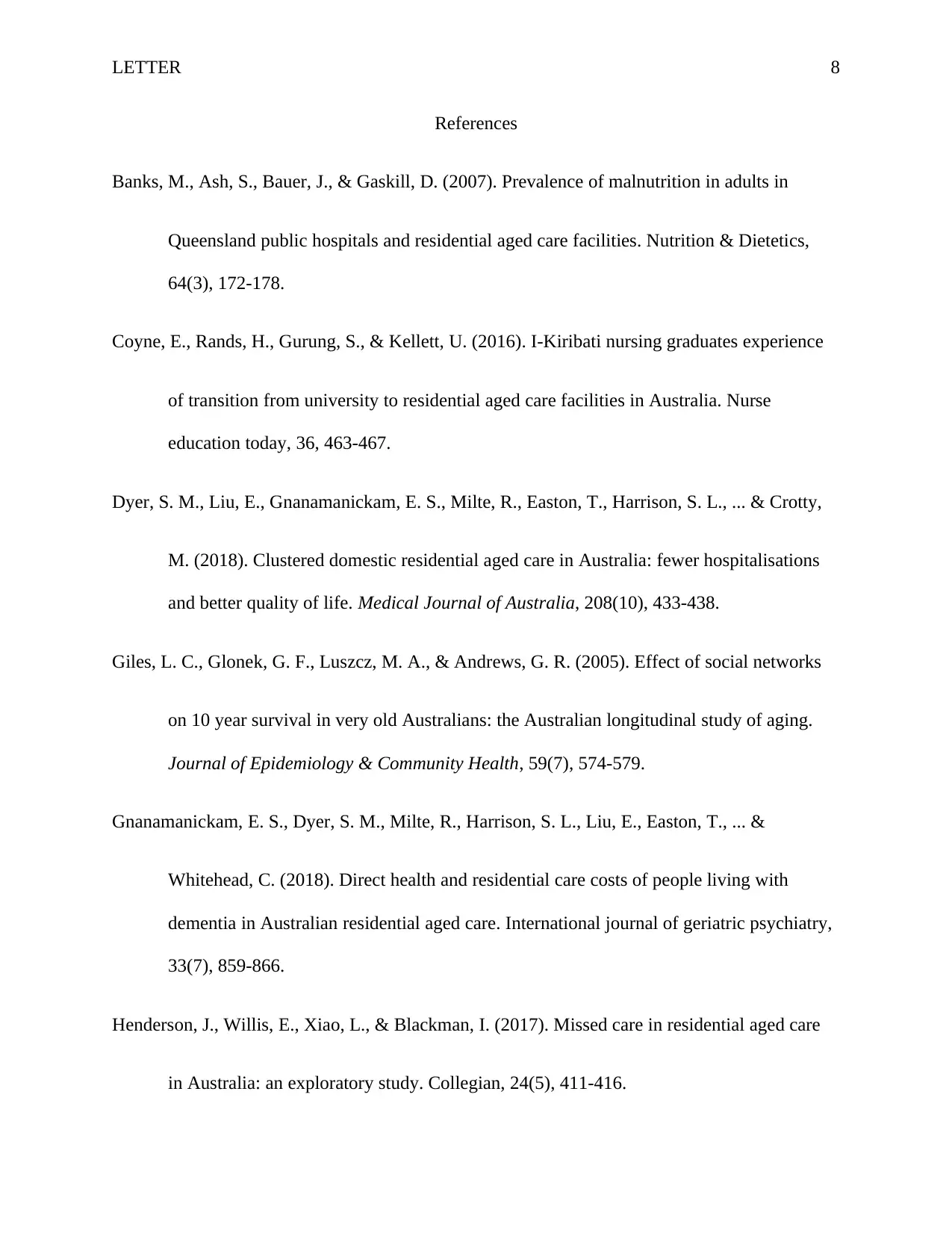
LETTER 8
References
Banks, M., Ash, S., Bauer, J., & Gaskill, D. (2007). Prevalence of malnutrition in adults in
Queensland public hospitals and residential aged care facilities. Nutrition & Dietetics,
64(3), 172-178.
Coyne, E., Rands, H., Gurung, S., & Kellett, U. (2016). I-Kiribati nursing graduates experience
of transition from university to residential aged care facilities in Australia. Nurse
education today, 36, 463-467.
Dyer, S. M., Liu, E., Gnanamanickam, E. S., Milte, R., Easton, T., Harrison, S. L., ... & Crotty,
M. (2018). Clustered domestic residential aged care in Australia: fewer hospitalisations
and better quality of life. Medical Journal of Australia, 208(10), 433-438.
Giles, L. C., Glonek, G. F., Luszcz, M. A., & Andrews, G. R. (2005). Effect of social networks
on 10 year survival in very old Australians: the Australian longitudinal study of aging.
Journal of Epidemiology & Community Health, 59(7), 574-579.
Gnanamanickam, E. S., Dyer, S. M., Milte, R., Harrison, S. L., Liu, E., Easton, T., ... &
Whitehead, C. (2018). Direct health and residential care costs of people living with
dementia in Australian residential aged care. International journal of geriatric psychiatry,
33(7), 859-866.
Henderson, J., Willis, E., Xiao, L., & Blackman, I. (2017). Missed care in residential aged care
in Australia: an exploratory study. Collegian, 24(5), 411-416.
References
Banks, M., Ash, S., Bauer, J., & Gaskill, D. (2007). Prevalence of malnutrition in adults in
Queensland public hospitals and residential aged care facilities. Nutrition & Dietetics,
64(3), 172-178.
Coyne, E., Rands, H., Gurung, S., & Kellett, U. (2016). I-Kiribati nursing graduates experience
of transition from university to residential aged care facilities in Australia. Nurse
education today, 36, 463-467.
Dyer, S. M., Liu, E., Gnanamanickam, E. S., Milte, R., Easton, T., Harrison, S. L., ... & Crotty,
M. (2018). Clustered domestic residential aged care in Australia: fewer hospitalisations
and better quality of life. Medical Journal of Australia, 208(10), 433-438.
Giles, L. C., Glonek, G. F., Luszcz, M. A., & Andrews, G. R. (2005). Effect of social networks
on 10 year survival in very old Australians: the Australian longitudinal study of aging.
Journal of Epidemiology & Community Health, 59(7), 574-579.
Gnanamanickam, E. S., Dyer, S. M., Milte, R., Harrison, S. L., Liu, E., Easton, T., ... &
Whitehead, C. (2018). Direct health and residential care costs of people living with
dementia in Australian residential aged care. International journal of geriatric psychiatry,
33(7), 859-866.
Henderson, J., Willis, E., Xiao, L., & Blackman, I. (2017). Missed care in residential aged care
in Australia: an exploratory study. Collegian, 24(5), 411-416.
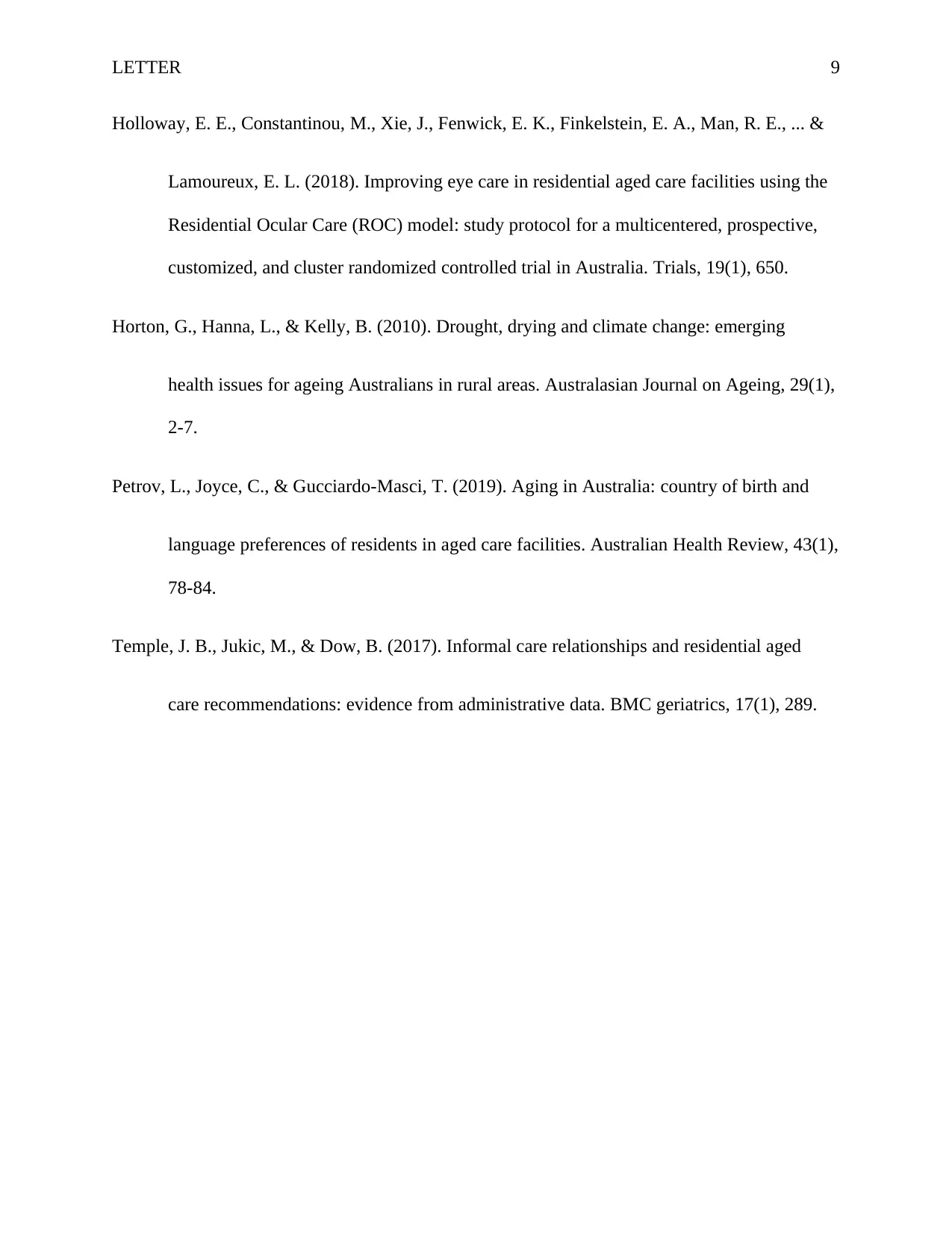
LETTER 9
Holloway, E. E., Constantinou, M., Xie, J., Fenwick, E. K., Finkelstein, E. A., Man, R. E., ... &
Lamoureux, E. L. (2018). Improving eye care in residential aged care facilities using the
Residential Ocular Care (ROC) model: study protocol for a multicentered, prospective,
customized, and cluster randomized controlled trial in Australia. Trials, 19(1), 650.
Horton, G., Hanna, L., & Kelly, B. (2010). Drought, drying and climate change: emerging
health issues for ageing Australians in rural areas. Australasian Journal on Ageing, 29(1),
2-7.
Petrov, L., Joyce, C., & Gucciardo-Masci, T. (2019). Aging in Australia: country of birth and
language preferences of residents in aged care facilities. Australian Health Review, 43(1),
78-84.
Temple, J. B., Jukic, M., & Dow, B. (2017). Informal care relationships and residential aged
care recommendations: evidence from administrative data. BMC geriatrics, 17(1), 289.
Holloway, E. E., Constantinou, M., Xie, J., Fenwick, E. K., Finkelstein, E. A., Man, R. E., ... &
Lamoureux, E. L. (2018). Improving eye care in residential aged care facilities using the
Residential Ocular Care (ROC) model: study protocol for a multicentered, prospective,
customized, and cluster randomized controlled trial in Australia. Trials, 19(1), 650.
Horton, G., Hanna, L., & Kelly, B. (2010). Drought, drying and climate change: emerging
health issues for ageing Australians in rural areas. Australasian Journal on Ageing, 29(1),
2-7.
Petrov, L., Joyce, C., & Gucciardo-Masci, T. (2019). Aging in Australia: country of birth and
language preferences of residents in aged care facilities. Australian Health Review, 43(1),
78-84.
Temple, J. B., Jukic, M., & Dow, B. (2017). Informal care relationships and residential aged
care recommendations: evidence from administrative data. BMC geriatrics, 17(1), 289.
⊘ This is a preview!⊘
Do you want full access?
Subscribe today to unlock all pages.

Trusted by 1+ million students worldwide
1 out of 9
Your All-in-One AI-Powered Toolkit for Academic Success.
+13062052269
info@desklib.com
Available 24*7 on WhatsApp / Email
![[object Object]](/_next/static/media/star-bottom.7253800d.svg)
Unlock your academic potential
Copyright © 2020–2025 A2Z Services. All Rights Reserved. Developed and managed by ZUCOL.